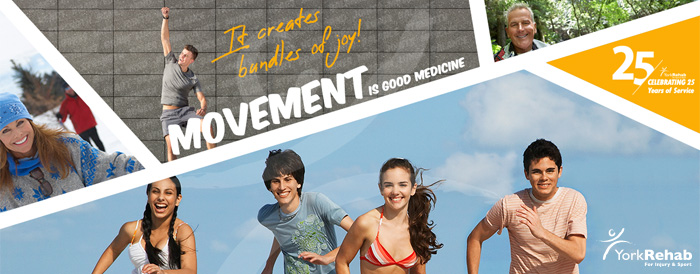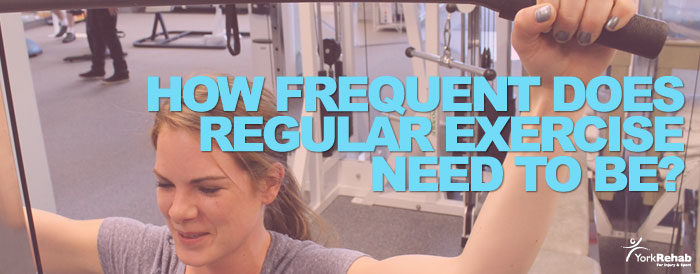Weight Loss
Movement is Good Medicine
Note: if you are not used to regular exercise, before beginning any new workout routine, it is important to CONSULT WITH A DOCTOR OR HEALTHCARE PROFESSIONAL.
Moving is the best thing you can do for your mind, body and soul. It provides a level of healing, sustenance and wellness that few things can compete with. We encourage our patients to move not just as a path to recovery but to employ it as a sustainable way for developing/maintaining strength and for general mental wellness. This is not new information for our readers, but the general practice by most does not include integrating movement into our lives daily in a meaningful way. We know moving is good for us, so why do so many of us neglect to move?
We Take Movement for Granted
We miss it most when it’s gone. We tend to only remember that movement is a privilege when we get injured. We are reminded of the luxury of being able to walk when we sprain an ankle, injure a knee or pull a hamstring. Or how important fingers are, only after we sprain one of them. Or how dependent we are on our back when strain or exertion from the day before makes it hard to sit up to get out of bed. There are countless instances where we are reminded of how important our bodies are not just to compete in sport but for everyday living.
What’s at Stake?
One thing is certain, the less we move now, over time than can translate into a decrease in our ability to move comfortably for everyday living. Everyday things like getting up from a chair, bending to pick up a box, putting on your socks, walking up steps, going down onto the floor. Whether you decide to move more or move less the effects will compound over time. Just like compounding interest, a little can grow into a lot. Investing in daily movement now will compound over time into building strength, heart health, improved mental wellness, lowering stress, minimizing joint pain, weight management, improved sleep, better balance and more brainpower. The reverse also holds, less movement will create the reverse effects with the same benefits just shared. And the effects can sneak up on you unexpectedly – coughing too hard throws out your back, you pull a hamstring running to catch a bus, etc.
So How Can We Move More?
If you’re interested in adding more movement into your day, be deliberate and create a plan. Start with figuring out what your goal is:
- Strengthening and muscle building
- Weight-loss
- Mental Wellness
- Improved Health
- Recovering from injury
- Improving or sustaining general health
Once you’ve identified your goal(s), it’s time to design a plan. Planning includes what type of activity you are going to do when you are going to do it, and whether you need some support (a friend or a trainer). The type of activity you decided on should be in alignment with your goal. For example, if you’re interested in sustaining your fitness level, 30 mins of daily activity can do the trick. But, if you are interested in strengthening or losing weight, you’ll need a larger time commitment (approx. 60 – 90 mins), at least 3 times a week.
To Build a Habit of Movement…Start Simple
If incorporating more movement/activity into your day, is a new thing for you start with simple steps. For example, don’t set a goal of running in a marathon in 3 months and schedule 30-minute runs 5 days a week. Instead, begin with basic movement like a 25-minute brisk walk every other day and build from there. If you prefer to walk inside you can check out Walk at Home by Leslie Sansone on Youtube. If building strength is the goal, it won’t be safe to start with 60-minute workouts lifting heavy weights. Begin with a 10 to 15-minute workout relying solely on body-weight – you can YouTube “HIIT workout”, “Calisthenics”, or “Full body workout, no equipment” for ideas and motivation (there are many videos to chose from).
Tips to Help You Succeed
- Each day that you complete your activity, note it on your calendar. You’ll be able to turn to it for motivation once you start to see the checkmarks adding up.
- Dress for success. The right attire can make you feel good and encourage you to stay active.
- Be comfortable with uncomfortable. As you transition into new activity and challenge your body, it may not always be enjoyable – no problem, understand that’s normal and embrace a bit of discomfort. (Note: if you feel pain, stop the movement and consult a healthcare provider).
- Schedule your activity. Give yourself a specific time of day that you plan to move and commit to it.
- Remember the why. Write down your goal and the reasons why so that you can refer to your notes from time to time for added motivation and encouragement.
Good Luck as You Work to Move More
Remember movement is good medicine. So, use it so you don’t lose it.
Disclaimer: Understand that when performing any exercise or exercise program, there is the possibility of physical injury. If you engage in any activity or exercise that’s referenced on the yorkrehab.com website, you agree that you do so at your own risk, are voluntarily participating in any such activity, assume all risk of injury to yourself, and agree to release and discharge York Rehab from any and all claims or causes of action, known or unknown, arising out of any content provided or referred to. The information provided on yorkrehab.com is not intended to be a substitute for medical guidance, diagnosis or treatment. You should not delay pursuing medical advice because of something you have read on this website. York Rehab (yorkrehab.com) is not responsible or liable for any advice, course of treatment, diagnosis or any other information, that appears throughout yorkrehab.com. If questions arise from any content that appears or is referred to on yorkrehab.com you are encouraged to consult a medical professional such as your doctor.
March…The Perfect Time for Resolutions
Most would not argue with the statement that 80-90% of people who start a New Year’s resolution at the beginning of January are probably not going to make it to February. Most resolutions are meant to improve people’s lives and make them happier, so it’s sad that so many people give up on their dreams so prematurely. There are varying reasons that can explain the failure to keep resolutions but some of the more common ones are connected to setting too many goals at once, making your goals too general or making them too big. Whether you’ve consciously or unconsciously abandoned your resolutions after only a few weeks of trying, the good news is you don’t have to wait until next January to make another attempt. March is the perfect time to pick yourself up, dust off and give it another go. Here are a few things that can help you make your second shot at your desired life change more permanent.
First, Look at the Data
If you’ve failed at keeping up your January resolutions, you’ve now accumulated useful data. Between when you started and when you quit, you can likely pull some information that can show you what worked with your attempt and what didn’t. Taking a closer can help you to figure out what things you can do differently so that you don’t repeat failure a second time. For example, maybe your resolution was to start exercising regularly (5 days a week), but you were only able to exercise 3 evenings the first week, then 1 evening each of the next two weeks. That data would show evening exercise didn’t fit well with your schedule. So on a second attempt at the resolution, exercising first thing in the morning would be a better plan.
Figure out what’s REALLY Important to You
People sometimes decide on resolutions for superficial reasons and a deeper look can uncover that a particular resolution may not really matter to you. You might have a resolution to stop eating chocolate – but upon closer inspection you discover that what you really want to do is start eating healthier as a whole. Deciding to focus on only eliminating chocolate from your diet wouldn’t yield you the type of results you want because you could simply replace one less than ideal food choice with another.
Be Specific with Your Goal Setting
Break down your goal into specific parts so you know exactly what you need to do, and when you plan to do it. The wrong way to approach a resolution like incorporating more exercise into your routine would be to say “I’m going to exercise more this year”. When you’re that vague, it allows you the flexibility to interpret “…exercise more…” any way you want – i.e. I exercised twice this month, hopefully I’ll exercise more next month. It may not unfold exactly that way but you get the gist. Instead, be specific on how you are going to integrate exercise into your routine, i.e. I’m going to do yoga four times a week on Mon, Wed, Fri and Sat first thing in the morning. By listing specific steps, you’ll know when you’re not keeping up and that you might need to address something in order to stay on track with your goal. Choose the SMART method for goal setting:
Specific
Measurable
Achievable
Relevant
Time-based
Don’t Do Too Much at Once
There’s an endless list of things one would want to change about themselves but trying to make many changes at once is usually difficult. Start with one goal and once you have built some momentum with maintaining it, only then should you consider working on another goal at the same time.
Create Accountability for Yourself
Don’t keep your goals hidden, share what you want to accomplish with someone close to you. You’ll be more committed when you know someone is watching. And invite them to inquire about your progress. When you know someone is going to check up on you, it’s added incentive for you to keep up with your efforts so you have results to communicate when you’re asked: “How are things going?”
Measure and Celebrate
Keep track of your progress, whether by journaling or marking progress on a calendar. A visual record of your progress helps you maintain momentum because it allows you to see how much you’ve already done. And identify milestones so that you can have mini celebrations along the way. If you need to lose 20lbs, it’s much better to celebrate each time you lose 5 than waiting to celebrate only after you’ve lost the full 20.
And Finally, Lighten Up!
Making a change is not easy, especially if it’s a significant change. There will be moments of discomfort and times when you just won’t do what you are supposed to do. If you have a moment of weakness and stumble, don’t use that as an excuse to quit – no one is perfect, failure along the way is normal. Also, accept that your goal won’t always be exciting and fun to tackle and that you may often not want to complete your task(s). Most of the time you probably won’t feel like doing what you should be doing – recognize that motivation won’t always accompany you. Despite the absence of motivation, do what you need to do anyway. Focus on developing the simple habits that will get you going, i.e. if you need to get in a morning run – just focus on getting your shoes on, and once those laces are tied what follows will be automatic.
Hidden Calories in Holiday Drinks
People concerned about calories often try to limit the intake of sweets over the holidays but may overlook another significant source of calories… alcoholic drinks! The number of calories in mixed drinks can add up quickly and could easily contribute to an expanding waistline during the holidays.
Indulging in an alcoholic beverage doesn’t have to derail your fitness efforts if you keep calories low and make wise choices. Learn how many calories are in four popular drinks and some options to reduce their calories:
Piña Colada
This tropical island treat is made with light rum, coconut milk, and pineapple juice. While the tropical taste may help ward off the winter blahs, you may end up singing the blues once you learn a 12-ounce drink has about 590 calories.
Lighter Option: Mix 1-ounce coconut rum with 4-ounces of pineapple juice over ice, top with club soda. By skipping the high fat and high-calorie coconut milk, you can reduce the calories by 75%.
Mudslide
Flavours of chocolate and coffee come together in this drink made with coffee-flavored liqueur, Irish cream, vodka, chocolate syrup and half-and-half cream. Due to the rich and creamy ingredients, a 6-ounce drink comes in at 560 calories.
Lighter Option: Skip the high-fat cream, ditch the chocolate syrup and Irish cream in favour of coffee liqueur, chocolate vodka mixed with low-fat milk.
Brandied Eggnog
For some, there is nothing more festive than sipping on spiked eggnog at a holiday gathering. The list of ingredients may be short – brandy combined with store bought eggnog – but the calorie count is high at over 400 calories per cup.
Lighter Option: Mix low-fat eggnog with cinnamon flavoured vodka to enjoy all the festive flavour and creaminess but for about half the calories.
Cosmopolitan
This classic martini is a staple on many drink lists thanks to Sex in the City. Made from vodka, orange liqueur, cranberry juice and lime, a 4-ounce drink has about 220 calories.
Lighter Option: Combine raspberry infused vodka, with a splash of cranberry and a squeeze of lime to save yourself a hundred calories.
Didn’t find your drink on the above list? Consider these other calorie saving suggestions:
- Drink liquor neat or on the rocks because it has fewer calories than a mixed drink
- Stick to clear liquors instead of creamy ones
- Ask for mixed drinks to be made with diet tonic or sodas, soda water or just a splash of juice
- Drink a light beer which has about 110 calories per 12-ounce bottle
- Toast the holidays with a glass of dry champagne which has about a 100 calories per 4-ounce glass
- Savour a glass of chardonnay or cabernet sauvignon which has about 125 calories per 4-ounce glass
- Alternate alcoholic drinks with sparkling water and lime – not only will this will keep you hydrated, it will also reduce how much you drink (in some cases by as much as half)!
Remember drinking these lower calorie options should still be done in moderation and paying attention to the portion size. Also please be responsible – don’t drink and drive. Happy Holidays from our Newmarket physiotherapy family to yours!
Add These 6 Things to Your Christmas Wish List
Christmas is just around the corner and between holiday parties and family functions, your fitness and healthy living choices may take a back seat to all the “excess”. Plus all of the social demands on your time can make sticking to a regular fitness routine difficult. But by asking Santa for the right gifts, you may be able to keep your fitness goals on track this holiday season.
Here is a cheat sheet of some inexpensive, yet effective fitness gifts to put on your wish list:
Yoga mat and yoga block
Some of the benefits of practicing yoga include increased flexibility, reduced stress, improved sleep and boosted immunity. While you don’t need to practice yoga in a fancy studio to reap these benefits, you do need a yoga mat. A yoga mat cushions your hands and feet and provides a non-stick practice surface. A must for any aspiring yogi!
If you think yoga poses are beyond your range of flexibility or strength, consider asking for a yoga block. Yoga blocks are brick shaped props made of cork, wood or hard foam that raise the floor to your hands of feet; therefore, helping make yoga poses easier and safer for beginners with limited flexibility or those experiencing reduced mobility.
Activity Tracker App
Downloading an activity tracker app, such as The Walk: Fitness Tracker Game or Zombies, Run! could be the inspiration you need to stay active. These apps immerse you in a story and provide you with a mission, which is finished by completing a specific distance or duration of activity. If you are not interested in participating in the story on a daily basis, the apps can also track your step count and distance covered.
IceTraxx
Wish you could keep walking, hiking and running outdoors this winter? But are worried about the possibility of slipping on icy sidewalks or trails? Then consider asking for a pair of IceTraxx to help increase traction and help prevent slips or falls on snow and ice. IceTraxx fit easily on most styles of boots or shoes without snaps, straps or buckles and will allow you to continue training outdoors this winter. These are available at our Newmarket physiotherapy clinic and affordably priced at $10.00 per pair.
TRX
It is pretty common to see a contraption with yellow and black straps hanging from the ceiling of your gym, but you may not be sure what it is. The TRX Suspension Trainer relies on gravity and your body-weight to provide a total body workout. With just one training tool you can complete a variety of exercises that will increase your heart rate and build strength. TRX is compact, lightweight and when used with a specialized door attachment can be used while traveling or at home.
A workout buddy
Include a “I need a fitness buddy” on your wish list this year. It would be wonderful if you were gifted a like-minded friend or family member to join you on your fitness journey towards pursuing a healthier lifestyle together. You could agree to meet at the gym a couple of nights a week, play squash together on the weekends, swim laps at the local community center before work, go for walks on your lunch break, sign up to take a kickboxing class together – the list of options is endless! No matter what you choose, exercising with someone else is a sure-fire way to stay motivated and committed to workout.
Workout attire
Now that you have exercise equipment and a workout partner, you need clothes to wear. From sports bras to shorts, to funny T-shirts to yoga pants, there are tons of clothing options to help you feel good during your workout. Plus having stylish workout gear may help get you in the mood to exercise and can help boost your confidence.
So there you have it, 6 Christmas gift ideas to help keep your fitness goals on track this holiday season and well into the New Year. If you’re looking for a fitness class, our Newmarket physiotherapy clinic offers different exercise classes in our Fitness Studio.
How Frequent does “Regular Exercise” Need to be
Most people don’t have endless amounts of time to spend in the gym every week. So it is a good thing regular exercise means only spending a minimum of 150 minutes a week doing cardiovascular/aerobic activity along with strength training. You can break that into 30-minute segments done five times a week or 40-minute sessions done 4 times a week.
Your exercise routine should include cardio, lifting weights and stretching, which can be combined or divided into separate sessions. But how much of each should you be doing? Here’s a suggested breakdown:
Cardio Exercise
Doing cardio burns calories and can help you achieve a weight-loss goal. It also keeps your circulatory system working optimally and builds your endurance.
How Often:
Aim to do cardio a minimum of 2 times per week for 30-45 minutes per session.
How to Do It:
The key to cardio is getting your heart beat up and breaking a sweat. Walking can be great but if you are not sweating, you need to pick up your pace. Aerobics, cycling, rollerblading, jogging or swimming are some great options that are sure to get your heart rate up.
Looking for something less mundane than walking or running? Here are some options that will have you sweating in no time (link to Zero Running Weight Loss Exercises).
Weight Training
The more muscle you have, the higher your metabolic rate (or calorie burning ability) will be. Lifting weights also help strengthen joints and bones.
How Often:
Aim to do weights 3 times per week for 30-45 minutes per session. Ideally, you should not do weight training on consecutive days. A recovery day or two allows your muscles to heal and rebuild themselves.
What to Do:
Include upper and lower body exercises to cover all major muscle groups. Be sure to lift weights that are heavy enough to tire the muscles – safe technique is key so consult a trainer or physiotherapist. Incorporate bodyweight moves (e.g. push ups, dips, chin ups, etc.) to challenge your body and increase the calorie burn.
Need some ideas on an exercise routine? Here are 6 great exercises you may have forgotten about.
Don’t Forget to Stretch!
Most people forget about stretching, but it is an important part of your exercise program.
How Often:
At least 2 to 3 times a week ideally after a workout.
How to Do It:
Stretch all major muscle groups after each workout, focusing on the body areas that you just finished exercising. Hold your stretches until the feeling of resistance, then breathe for at least a count of ten before releasing. If you experience pain during a stretch, do not continue that movement – if the pain persists consult a health professional to ensure you’re not injuring yourself. Want to know why you should stretch? Here are 4 reasons (link to stretching article).
Scheduled physical activity that helps you reach the recommended 150 minutes of exercise a week can be considered regular exercise. If you’re already active, use the measure of sweating and slight muscle soreness as a marker that your intensity level qualifies as exercise. The more regular you are with exercise the easier it becomes so continue to increase your cardio intensity and move towards lifting heavier weights to challenge your muscles, so you can continue to reap the benefits of regular exercise.
Just starting out? Take it slow with three sessions of 20 minutes each week and build up from there. Never exercised before or are unsure of how to get started? You can make an appointment to see one of our physiotherapists who can help you start exercising regularly – we also offer fitness classes for beginners.






